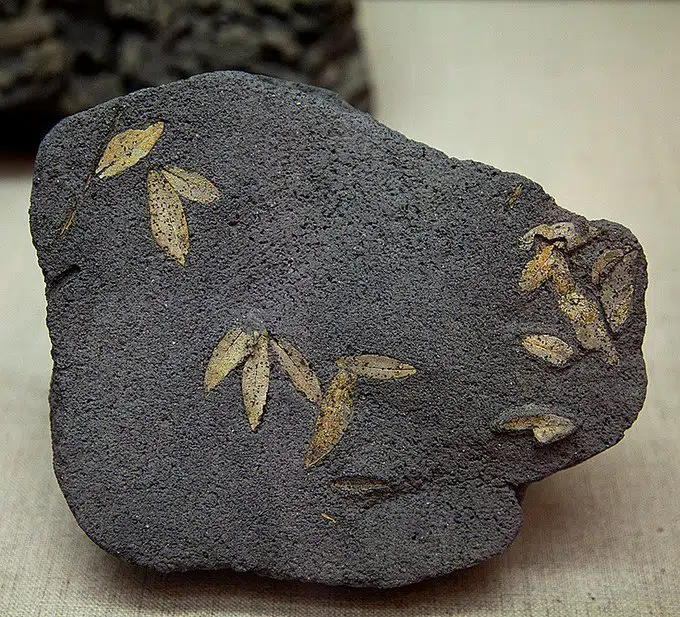
Fossilized olive leaves from a tree that was alive 60,000 years ago on the island of Thira (the modern Santorini) are immortalized in the volcanic ash that encased them after an eruption.
The exquisite fossils were discovered at an old pumice quarry on the outskirts of Thira, a town on Santorini; in addition, three new plant fossil sites were also located in abandoned quarries nearby on the island, which was almost completely destroyed in a later eruption that occurred in the year 1650 BC.
Blowing apart the island that at that time was called Thira by its Minoan inhabitants, all that was left was a rim of land encircling a caldera; now known as Santorini, the crescent-shaped island marks one of the most cataclysmic eruptions that has ever taken place within recorded history.
Many historians also believe that it forms the basis for the legend of Atlantis, an island which similarly fell back into the sea.
The fossilized olive leaves are now exhibited at the Museum of Prehistoric Thera in the capital Fira on Santorini.
The Museum is a state-of-the-art building made possible by the work of Greek archeologist Spyridon Marinatos, who led excavations in the archaeological site of Akrotiri, a thriving urban center that thrived during the Minoan Bronze Age.
Museum of Prehistoric Thera displays treasures of Minoan civilization
Later finds at the site even uncovered a new species of plant, called Ramnos alaternos. Volcanic deposits on the wall of the caldera in the Old Fira quarries even contain feathers and olive stones.
Athens University researchers say that the olive leaves, among other finds, show that hundreds of not naturally occurring, but domesticated, olive, mastic and pistachio trees were preserved in the volcanic ash of successive eruptions thousands of years ago.
The Athens researchers carefully documented the island’s natural resources, geological monuments, geotopes and geological heritage as part of the ongoing excavations around the island.
Learn more: Akrotiri, Santorini- The Bronze Age City Preserved in Ash
The rare paleobotanical finds that the team discovered in the Fira quarries over a decade of research are very significant because they contain valuable information about the flora and climatic conditions of the Cyclades at that time.
According to Evangelos Velitzelos, the head of Athens University’s Department of Historical Geology and Paleontology, the plant fossils that were found in layers of volcanic ash 60,000 years old were isolated by special conservation methods.
Along with the beautiful leaves of the European olive, the researchers discovered leaves from the dwarf palm and the Cretan palm tree, or Phoenix Theophrasti, which also is found at Vai on Crete, as well as mastic and tamarisk trees.
Amazingly, the researchers were also able to determine that the climate so many tens of thousands of years ago was quite different than it is today, amounting to a completely different biome than the area enjoys today, in the temperate zone.
The fossilized leaves and other objects found immortalized in the volcanic ash indicates that the prevailing climate was hot, without harsh winters at all. “The climate of Santorini 60,000 years ago was very warm, not even Mediterranean but subtropical,” Velitzelos stated.
A place which had a long history of volcanic activity — which still continues today — is evidenced by layers of ash that trapped the flora, the professor explained. “Plants with thin leaves were destroyed, while the rest began the process of fossilization. Plants with tough leaves, such as olives or palms, retained their original epidermis in most cases. That is why we able to determine their genus and species with such certainty,” he noted.
These exquisite fossils and many others found around the caldera of Santorini are on display at the Prehistory Museum of Santorini and the island’s Cultural Association, the Fossilized Forest Natural History Museum of Mytilene and the Museum of the Olive and Greek Oil in Sparta as well.
Venitzelos notes that there is enough paleobotanical material for a standalone paleontology museum on Santorini. The Santorini municipality and a panel of experts are currently examining a proposal for such a museum to highlight the fascinating and beautiful history of plants in the Aegean.
See all the latest news from Greece and the world at Greekreporter.com. Contact our newsroom to report an update or send your story, photos and videos. Follow GR on Google News and subscribe here to our daily email!



